Schneider Electric Altivar71 User Manual
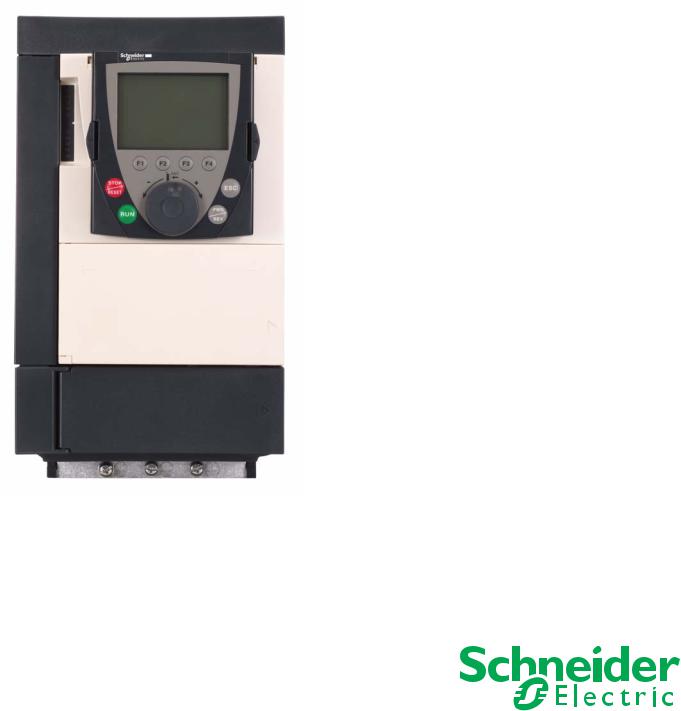
Altivar 71
Variable speed drives
for synchronous and asynchronous motors
Programming manual
Software V3.3
12/2009
1755855
www.schneider-electric.com

Contents
Before you begin______________________________________________________________________________________________ 4 Documentation structure________________________________________________________________________________________ 5 Software enhancements________________________________________________________________________________________ 6 Steps for setting up____________________________________________________________________________________________ 9 Factory configuration _________________________________________________________________________________________ 10 Application functions__________________________________________________________________________________________ 11 Setup - Preliminary recommendations ____________________________________________________________________________ 15 Graphic display terminal _______________________________________________________________________________________ 18
Description of terminal __________________________________________________________________________________ 18 Description of the graphic screen __________________________________________________________________________ 19 First power-up - [5. LANGUAGE] menu _____________________________________________________________________ 22 Subsequent power ups__________________________________________________________________________________ 23 Programming: Example of accessing a parameter_____________________________________________________________ 24 Quick navigation _______________________________________________________________________________________ 25
Integrated display terminal _____________________________________________________________________________________ 28 Functions of the display and the keys_______________________________________________________________________ 28 Accessing menus ______________________________________________________________________________________ 29 Accessing menu parameters _____________________________________________________________________________ 30 [2. ACCESS LEVEL] (LAC-) ____________________________________________________________________________________ 31
Structure of parameter tables ___________________________________________________________________________________ 34 Interdependence of parameter values ____________________________________________________________________________ 35 Finding a parameter in this document ____________________________________________________________________________ 36 [1.1 SIMPLY START] (SIM-)____________________________________________________________________________________ 37 [1.2 MONITORING] (SUP-) ____________________________________________________________________________________ 45 [1.3 SETTINGS] (SEt-) ________________________________________________________________________________________ 54 [1.4 MOTOR CONTROL] (drC-) _________________________________________________________________________________ 68 [1.5 INPUTS / OUTPUTS CFG] (I-O-) ____________________________________________________________________________ 88 [1.6 COMMAND] (CtL-)_______________________________________________________________________________________ 116 [1.7 APPLICATION FUNCT.] (FUn-) ____________________________________________________________________________ 129 [1.8 FAULT MANAGEMENT] (FLt-) _____________________________________________________________________________ 215 [1.9 COMMUNICATION] (COM-) _______________________________________________________________________________ 239 [1.10 DIAGNOSTICS]________________________________________________________________________________________ 243 [1.11 IDENTIFICATION] ______________________________________________________________________________________ 245 [1.12 FACTORY SETTINGS] (FCS-) ____________________________________________________________________________ 246 [1.13 USER MENU] (USr-) ____________________________________________________________________________________ 249 [1.14 PROGRAMMABLE CARD] (PLC-) _________________________________________________________________________ 250 [3. OPEN/SAVE AS] _________________________________________________________________________________________ 251 [4. PASSWORD] (COd-)______________________________________________________________________________________ 253 [6 MONITORING CONFIG.] ___________________________________________________________________________________ 255 [7 DISPLAY CONFIG.] _______________________________________________________________________________________ 259 [MULTIPOINT SCREEN] _____________________________________________________________________________________ 264 Maintenance _______________________________________________________________________________________________ 265 Faults - Causes - Remedies ___________________________________________________________________________________ 266 User settings tables _________________________________________________________________________________________ 272 Index of functions ___________________________________________________________________________________________ 274 Index of parameter codes_____________________________________________________________________________________ 275
1755855 |
12/2009 |
3 |

Before you begin
Read and understand these instructions before performing any procedure on this drive.
 DANGER
DANGER
HAZARDOUS VOLTAGE
•Read and understand the Installation Manual before installing or operating the ATV71 drive. Installation, adjustment, repair, and maintenance must be performed by qualified personnel.
•The user is responsible for compliance with all international and national electrical standards in force concerning protective grounding of all equipment.
•Many parts of this variable speed drive, including the printed circuit boards, operate at the line voltage. DO NOT TOUCH.
Use only electrically insulated tools.
•DO NOT touch unshielded components or terminal strip screw connections with voltage present.
•DO NOT short across terminals PA/+ and PC/- or across the DC bus capacitors.
•Install and close all the covers before applying power or starting and stopping the drive.
•Before servicing the variable speed drive
-Disconnect all power.
-Place a “DO NOT TURN ON” label on the variable speed drive disconnect.
-Lock the disconnect in the open position.
•Disconnect all power including external control power that may be present before servicing the drive. WAIT 15 MINUTES to allow the DC bus capacitors to discharge. Then follow the DC bus voltage measurement procedure given in the Installation Manual to verify that the DC voltage is less than 42 V. The drive LEDs are not accurate indicators of the absence of DC bus voltage.
Failure to follow these instructions will result in death or serious injury.
CAUTION
DAMAGED EQUIPMENT
Do not operate or install any drive that appears damaged.
Failure to follow this instruction can result in equipment damage.
4 |
1755855 |
12/2009 |

Documentation structure
The following Altivar 71 technical documents are available on the Telemecanique website (www.telemecanique.com) as well as on the CD-ROM supplied with the drive.
Installation Manual
This bulletin contains complete mounting and wiring instructions.
Programming manual
This describes the functions, parameters and use of the drive terminal (integrated display terminal and graphic display terminal). The communication functions are not described in this manual, but in the manual for the bus or network used.
Communication Parameters Manual
This manual describes:
•The drive parameters with specific information for use via a bus or communication network.
•The operating modes specific to communication (state chart).
•The interaction between communication and local control.
Manuals for Modbus, CANopen, Ethernet, Profibus, INTERBUS, Uni-Telway, FIPIO and Modbus Plus, etc.
These manuals describe the assembly, connection to the bus or network, signaling, diagnostics, and configuration of the communicationspecific parameters via the integrated display terminal or the graphic display terminal.
They also describe the communication services of the protocols.
ATV 58-58F/ATV 71 Migration Manual
This manual describes the differences between the Altivar 71 and the Altivar 58/58F and explains how to replace an Altivar 58 or 58F, including how to replace drives communicating on a bus or a network.
ATV 78/ATV 61/71 Migration Manual
This manual describes the differences between the Altivar 61/71 and Altivar 78 and explains how to replace an Altivar 78.
1755855 |
12/2009 |
5 |

Software enhancements
Since the Altivar ATV 71 was first launched, it has benefited from the addition of several new functions. The software version has been updated to V3.3. The old versions can be replaced by this new one without any modifications.
Although this documentation relates to version V3.3, it can still be used with earlier versions, as the updates merely involve the addition of values and parameters, and none of the parameters of the previous versions have been modified or removed.
Enhancements made to version V1.2 in comparison to V1.1
Factory setting
Note 1: In version V1.1, the analog input was 0 ± 10 V. For safety reasons, in the new version this input has been set to 0 + 10 V. Note 2: In version V1.1, analog output AO1 was assigned to the motor frequency. In the new version, this output is not assigned at all.
With the exception of these two parameters, the factory settings of version V1.1 remain the same in the new version. The new functions are factory-set to disabled.
Motor frequency range
The maximum output frequency has been extended from 1000 to 1600 Hz (depending on the drive rating and control profile).
New parameters and functions
Menu [1.2 MONITORING] (SUP-)
Addition of internal states and values relating to the new functions described below.
Menu [1.3 SETTINGS] (SEt-)
•[High torque thd.] (ttH) page 66.
•[Low torque thd.] (ttL) page 66.
•[Pulse warning thd.] (FqL) page 67.
•[Freewheel stop Thd.] (FFt) page67.
Menu[1.4 MOTOR CONTROL] (drC-)
•[rpm increment] (InSP) page 69.
•Extension of the following configurations to all drive ratings; previously limited to 45 kW (60 HP) for ATV71pppM3X and to 75 kW (100 HP) for ATV71pppN4:synchronous motor[Sync. mot.] (SYn) page 71, sinus filter [Sinus filter] (OFI) page 82, noise reduction [Noise reduction] (nrd) page 83, braking balance [Braking balance] (bbA) page 85.
Menu [1.5 INPUTS / OUTPUTS CFG] (I-O-)
•Input Al1 can now be configured to 0 +10 V or 0 ± 10 V via [AI1 Type] (AI1t) page 94.
•[AI net. channel] (AIC1) page 98.
•New methods of assigning relays and logic outputs page 103 : rope slack, high torque threshold, low torque threshold, motor in forward rotation, motor in reverse rotation, measured speed threshold reached, load variation detection.
•Analog output AO1 can now be used as a logic output and assigned to relay functions and logic outputs, page 108.
•New method of modifying the scale of analog outputs page 110 using the parameters [Scaling AOx min] (ASLx) and [Scaling AOx max] (ASHx).
•New methods of assigning logic outputs page 111: signed motor torque and measured motor speed.
•New methods of assigning alarm groups page 115 : rope slack, high torque threshold, low torque threshold, measured speed threshold reached, load variation detection.
6 |
1755855 |
12/2009 |

Software enhancements
Menu [1.7 APPLICATION FUNCT.] (Fun-)
•The summing, subtraction and multiplication reference functions can now be assigned to virtual input [Network AI] (AIU1) page 136.
•New parameter [Freewheel stop Thd.] (FFt) page 141 used to set a threshold for switching to freewheel at the end of a stop on ramp or fast stop.
•Brake engage at regulated zero speed [Brake engage at 0] (bECd) page 162.
•Weight [Weight sensor ass.] (PES) page 167 can now be assigned to virtual input [Network AI] (AIU1).
•New "rope slack" function page 171, with the parameters [Rope slack config.] (rSd) and [Rope slack trq level] (rStL).
•Use of the ramp [Acceleration 2] (AC2) page 179 when starting and "waking up" the PID function.
•The torque limitation [TORQUE LIMITATION] (tOL-) page 186 can now be configured in whole % or in 0.1% increments using [Torque increment] (IntP) and assigned to virtual input [Network AI] (AIU1).
•New "stop at distance calculated after deceleration limit switch" function page 195, with the parameters [Stop distance] (Std), [Rated linear speed] (nLS) and [Stop corrector] (SFd).
•Positioning by sensors or limit switch [POSITIONING BY SENSORS] (LPO-) page 196 can now be configured in positive logic or negative logic using [Stop limit config. (SAL) and [Slowdown limit cfg.] (dAL).
•Parameter set switching [PARAM. SET SWITCHING] (MLP-) page 199 can now be assigned to the frequency thresholds attained [Freq. Th. att.] (FtA) and [Freq. Th. 2 attain.] (F2A).
•New half-floor: menu [HALF FLOOR] (HFF-) page 213.
Menu [1.8 FAULT MANAGEMENT] (FLt)
•Possibility of reinitializing the drive without turning it off, via [Product reset] (rP) page 220.
•Possibility of reinitializing the drive via a logic input without turning it off, using [Product reset assig.] (rPA) page 220.
•The possibility of configuring the "output phase loss" fault [Output Phase Loss] (OPL) page 224 to [Output cut] (OAC) has been extended to all drive ratings (previously limited to45 kW (60 HP) for ATV71pppM3X and 75 kW (100HP) for ATV71pppN4).
•The external fault [EXTERNAL FAULT] (EtF-) page 227 can now be configured in positive or negative logic via [External fault config.] (LEt).
•New monitoring function based on speed measurement via "Pulse input" page 234, via the [FREQUENCY METER] menu (FqF-).
•New function for detecting load variation page 236, via the [DYNAMIC LOAD DETECT] menu (dLd-).
•Short-circuit faults on the braking unit can now be configured via[Brake res. fault Mgt] bUb) page 238.
Menu [7 DISPLAY CONFIG.]
•In [7.4 KEYPAD PARAMETERS] page 261, the [KEYPAD CONTRAST] and [KEYPAD STAND-BY] parameters to adjust the contrast and stand-by mode of the graphic display unit.
Enhancements made to version V1.6 in comparison to V1.2
Extension of the range with the addition of ATV71ppppY drives for 500 to 690 V supplies.
There are no new parameters, but the adjustment ranges and factory settings of some parameters have been adapted to the new voltages.
Menu [1.5 INPUTS / OUTPUTS CFG] (I-O-)
Increased adjustment range for the relay and logic output delay parameters: 0 to 60000 ms instead of 0 to 9999 ms.
Enhancements made to version V2.5 in comparison to V1.6
Menu [1.3 SETTINGS] (SEt-)
•New parameters [Skip Frequency] (JPF), [Skip Frequency 2] (JF2) and [3rd Skip Frequency] (JF3) page 67 allow to avoid critical speed which generate resonances.
•New parameter [Skip.Freq.Hysteresis] (JFH) page 67 to adjust the range of skip frequency.
•Possibility to adjust the parameter [Torque ratio] (trt) page 67 (visible too in [TORQUE CONTROL] (tOr-) menu page 183).
Important:
For V2.5 version, the behaviour of the following functions is different from the previous version when type of stop "freewheel" is selected (factory value):
•[LIMIT SWITCHES] (LSt-) function,
•[POSITIONING BY SENSORS] (LPO-) function,
•"shutdown" command by communication (see CiA402 state chart in communication parameters manual). Actually, on previous versions, type of stop "freewheel" was not well done.
1755855 |
12/2009 |
7 |

Software enhancements
Enhancements made to version V2.7 in comparison to V2.5
Menu [7 DISPLAY CONFIG.]
•Addition in [7.4 KEYPAD PARAMETERS] page 261 of [Power up menu]. This parameter allows to choose the menu which displays on the drive on power up.
Menu [1.3 SETTINGS] (SEt-)
The adjustment range of [Time to restart] (ttr) page 163 can now be configured between 0.00 and 15.00 seconds.
Enhancements made to version V3.3 in comparison to V2.7
[1.7 APPLICATION FUNCT.] (Fun-) menu
New parameters and functions
•New parameter [REGEN CONNECTION] (AFE) page 215 . With this parameter it is possible to retun the braking energy to the mains and reduce the harmonics
8 |
1755855 |
12/2009 |
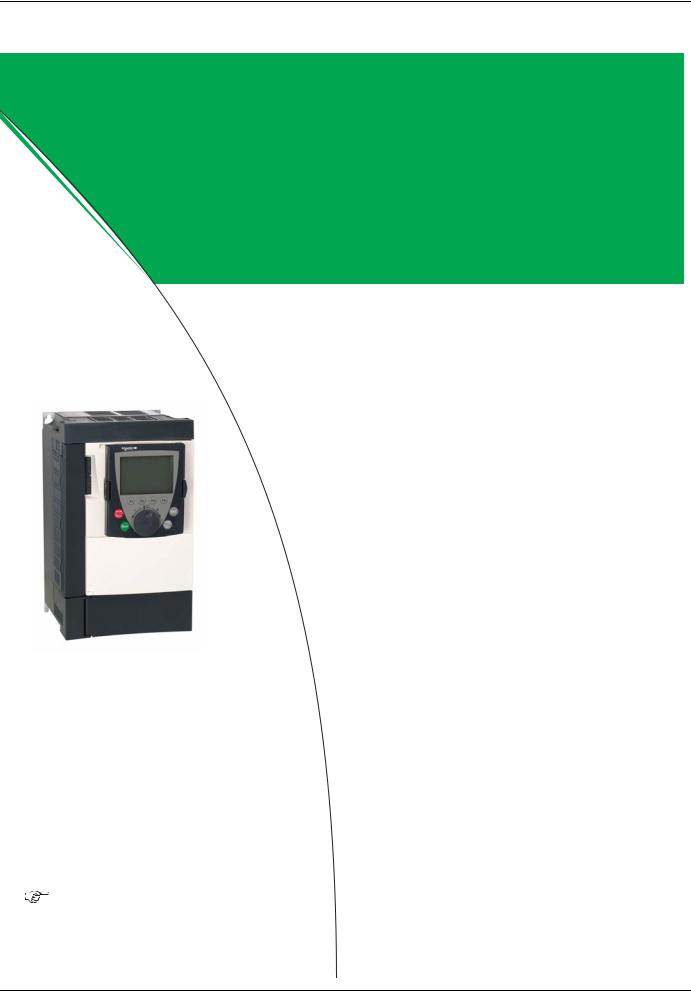
Steps for setting up
INSTALLATION
v 1 Consult the Installation Manual
PROGRAMMING
Procedure applicable if the factory configuration, page 10, and use of the [SIMPLY START] (SIM-) menu only are sufficient for the application.
b 2 Power up without run command
v If you are using a separate power supply for the control section, follow the instructions on page 15.
Tips:
•Before you start programming, complete the user setting tables, page 274.
b 3 Select the language, if the drive has a graphic display terminal
b 4 Configure the [SIMPLY START] (SIM-) menu
v 2-wire or 3-wire control v Macro configuration
vMotor parameters
) Perform an auto-tuning
•Perform an auto-tuning operation to optimize performance, page 43.
•If you get lost, return to the factory settings, page 250.
Note: Check that the wiring of the drive is compatible with its configuration.
operation
v Motor thermal current
v Acceleration and deceleration ramps
v Speed variation range
b 5 Start
1755855 |
12/2009 |
9 |

Factory configuration
Drive factory settings
The Altivar 71 is factory-set for the most common operating conditions:
•Macro configuration: Start/Stop
•Motor frequency: 50 Hz
•Constant torque application with asynchronous motor and sensorless flux vector control
•Normal stop mode on deceleration ramp
•Stop mode in the event of a fault: freewheel
•Linear, acceleration and deceleration ramps: 3 seconds
•Low speed: 0 Hz
•High speed: 50 Hz
•Motor thermal current = rated drive current
•Standstill injection braking current = 0.7 x rated drive current, for 0.5 seconds
•No automatic starts after a fault
•Switching frequency 2.5 kHz or 4 kHz depending on drive rating
•Logic inputs:
-LI1: forward, LI2: Forward (2 operating direction), 2-wire control on transition
-L13, L14, LI5, LI6: inactive (not assigned)
•Analog inputs:
-AI1: speed reference 0 +10 V
-AI2: 0-20 mA, inactive (not assigned)
•Relay R1: The contact opens in the event of a fault (or drive off).
•Relay R2: Inactive (not assigned)
•Analog output AO1: 0-20 mA, inactive (not assigned)
If the above values are compatible with the application, the drive can be used without changing the settings.
Option card factory settings
The option card inputs/outputs are not factory-set.
10 |
1755855 |
12/2009 |

Application functions
The tables on the following pages show the most common combinations of functions and applications, in order to guide your selection. The applications in these tables relate to the following machines in particular:
•Hoisting: cranes, overhead cranes, gantries (vertical hoisting, translation, slewing), lifting platforms
•Elevators: elevators in retrofit up to 1.2 m/s
•Handling: palletizers/depalletizers, conveyors, roller tables
•Packing: carton packers, labeling machines
•Textiles: weaving looms, carding frames, washing machines, spinners, drawing frames
•Wood: automatic lathes, saws, milling
•High inertia: centrifuges, mixers, unbalanced machines (beam pumps, presses)
•Process
Each machine has its own special features, and the combinations listed here are neither mandatory nor exhaustive.
Some functions are designed specifically for a particular application. In this case, the application is identified by a tab in the margin on the relevant programming pages.
Motor control functions
|
|
|
|
|
Applications |
|
|
|
|
Functions |
Page |
Hoisting |
|
Handling |
Packing |
Textiles |
Wood |
High inertia |
Process |
|
|
Lifts |
|||||||
|
|
|
|
|
|
|
|
|
|
V/f ratio |
71 |
|
|
b |
|
|
b |
b |
|
|
|
|
|
|
|
|
|
|
|
Sensorless flux vector control |
71 |
b |
b |
b |
b |
b |
b |
b |
b |
|
|
|
|
|
|
|
|
|
|
Flux vector control with sensor |
71 |
b |
b |
b |
b |
b |
b |
b |
b |
|
|
|
|
|
|
|
|
|
|
2-point vector control |
71 |
b |
|
|
|
b |
|
|
|
|
|
|
|
|
|
|
|
|
|
Open-loop synchronous motor |
71 |
|
|
|
|
b |
|
|
|
|
|
|
|
|
|
|
|
|
|
Output frequency of up to 1600 Hz |
69 |
|
|
|
|
b |
b |
|
|
|
|
|
|
|
|
|
|
|
|
Motor overvoltage limiting |
83 |
|
|
|
|
b |
b |
|
|
|
|
|
|
|
|
|
|
|
|
DC bus connection (see User's Manual) |
- |
|
|
|
|
b |
|
|
b |
|
|
|
|
|
|
|
|
|
|
Motor fluxing using a logic input |
154 |
b |
|
b |
b |
|
|
|
|
|
|
|
|
|
|
|
|
|
|
Switching frequency of up to 16 kHz |
82 |
|
b |
|
|
b |
b |
|
|
|
|
|
|
|
|
|
|
|
|
Auto-tuning |
70 |
b |
b |
b |
b |
b |
b |
b |
b |
|
|
|
|
|
|
|
|
|
|
1755855 |
12/2009 |
11 |

Application functions
Functions on speed references
|
|
|
|
|
Applications |
|
|
|
|
Functions |
Page |
Hoisting |
Lifts |
Handling |
Packing |
Textiles |
Wood |
inertiaHigh |
Process |
|
|
|
|
|
|
|
|
||
|
|
|
|
|
|
|
|
|
|
Differential bipolar reference |
91 |
b |
|
b |
b |
|
|
|
|
|
|
|
|
|
|
|
|
|
|
Reference delinearization (magnifying glass effect) |
93 |
b |
|
b |
|
|
|
|
|
|
|
|
|
|
|
|
|
|
|
Frequency control input |
125 |
|
|
|
|
b |
|
|
b |
|
|
|
|
|
|
|
|
|
|
Reference switching |
126 - 135 |
|
|
|
b |
|
|
|
|
|
|
|
|
|
|
|
|
|
|
Reference summing |
134 |
|
|
|
b |
|
|
|
|
|
|
|
|
|
|
|
|
|
|
Reference subtraction |
134 |
|
|
|
b |
|
|
|
|
|
|
|
|
|
|
|
|
|
|
Reference multiplication |
134 |
|
|
|
b |
|
|
|
|
|
|
|
|
|
|
|
|
|
|
S ramps |
137 |
b |
b |
b |
|
|
|
|
|
|
|
|
|
|
|
|
|
|
|
Jog operation |
145 |
|
|
b |
|
b |
|
|
b |
|
|
|
|
|
|
|
|
|
|
Preset speeds |
146 |
b |
b |
b |
b |
|
|
b |
|
|
|
|
|
|
|
|
|
|
|
+ speed / - speed using single action pushbuttons |
149 |
|
|
|
|
|
|
|
b |
(1 step) |
|
|
|
|
|
|
|
|
|
|
|
|
|
|
|
|
|
|
|
|
|
|
|
|
|
|
|
|
|
+ speed / - speed using double action pushbuttons |
149 |
b |
|
|
|
|
|
|
|
(2 steps) |
|
|
|
|
|
|
|
|
|
+/- speed around a reference |
151 |
|
|
|
|
b |
|
|
b |
|
|
|
|
|
|
|
|
|
|
Save reference |
153 |
|
|
|
|
|
|
|
b |
|
|
|
|
|
|
|
|
|
|
12 |
1755855 |
12/2009 |

Application functions
Application-specific functions
|
|
|
|
|
Applications |
|
|
|
|
Functions |
Page |
Hoisting |
Lifts |
Handling |
Packing |
Textiles |
Wood |
inertiaHigh |
Process |
|
|
|
|
|
|
|
|
||
|
|
|
|
|
|
|
|
|
|
Fast stop |
141 |
|
|
|
|
|
b |
b |
|
|
|
|
|
|
|
|
|
|
|
Limit switch management |
155 |
b |
b |
b |
|
|
|
|
|
|
|
|
|
|
|
|
|
|
|
Brake control |
157 |
b |
b |
b |
|
|
|
|
|
|
|
|
|
|
|
|
|
|
|
Load measurement |
166 |
b |
b |
|
|
|
|
|
|
|
|
|
|
|
|
|
|
|
|
High-speed hoisting |
168 |
b |
|
|
|
|
|
|
|
|
|
|
|
|
|
|
|
|
|
Rope slack |
171 |
b |
|
|
|
|
|
|
|
|
|
|
|
|
|
|
|
|
|
PID regulator |
173 |
|
|
|
|
|
|
|
b |
|
|
|
|
|
|
|
|
|
|
Torque monitoring |
182 |
|
|
b |
|
b |
|
|
b |
|
|
|
|
|
|
|
|
|
|
Motor/generator torque limit |
185 |
|
|
b |
|
b |
|
b |
b |
|
|
|
|
|
|
|
|
|
|
Load sharing |
85 |
b |
|
b |
|
|
|
|
|
|
|
|
|
|
|
|
|
|
|
Line contactor control |
189 |
b |
|
b |
|
|
b |
|
|
|
|
|
|
|
|
|
|
|
|
Output contactor control |
191 |
|
b |
|
|
|
|
|
|
|
|
|
|
|
|
|
|
|
|
Positioning by limit switches or sensors |
193 |
|
|
b |
b |
|
|
|
|
|
|
|
|
|
|
|
|
|
|
Stop at distance calculated after deceleration limit switch |
195 |
|
|
b |
b |
|
|
|
|
|
|
|
|
|
|
|
|
|
|
ENA system (mechanical with unbalanced load) |
80 |
|
|
|
|
|
|
b |
|
|
|
|
|
|
|
|
|
|
|
Parameter switching |
198 |
b |
b |
b |
b |
b |
b |
b |
b |
|
|
|
|
|
|
|
|
|
|
Motor or configuration switching |
201 |
b |
|
b |
b |
|
|
|
|
|
|
|
|
|
|
|
|
|
|
Traverse control |
205 |
|
|
|
|
b |
|
|
|
|
|
|
|
|
|
|
|
|
|
Stop configuration |
141 |
|
|
b |
|
b |
b |
b |
|
|
|
|
|
|
|
|
|
|
|
Evacuation |
212 |
|
b |
|
|
|
|
|
|
|
|
|
|
|
|
|
|
|
|
Half floor |
213 |
|
b |
|
|
|
|
|
|
|
|
|
|
|
|
|
|
|
|
1755855 |
12/2009 |
13 |

Application functions
Safety functions/fault management
|
|
|
|
|
Applications |
|
|
|
|
Functions |
Page |
Hoisting |
Lifts |
Handling |
Packing |
Textiles |
Wood |
inertiaHigh |
Process |
|
|
|
|
|
|
|
|
||
|
|
|
|
|
|
|
|
|
|
Power Removal (safety function, see User's Manual) |
- |
b |
b |
b |
b |
b |
b |
b |
b |
|
|
|
|
|
|
|
|
|
|
Deferred stop on thermal alarm |
226 |
|
b |
|
|
|
|
|
|
|
|
|
|
|
|
|
|
|
|
Alarm handling |
115 |
b |
b |
b |
b |
b |
b |
b |
b |
|
|
|
|
|
|
|
|
|
|
Fault management |
218 to 240 |
b |
b |
b |
b |
b |
b |
b |
b |
|
|
|
|
|
|
|
|
|
|
IGBT tests |
229 |
b |
b |
b |
b |
b |
b |
b |
b |
|
|
|
|
|
|
|
|
|
|
Catch a spinning load |
222 |
|
|
|
|
b |
b |
b |
|
|
|
|
|
|
|
|
|
|
|
Braking resistor thermal protection |
238 |
b |
b |
b |
b |
|
|
|
|
|
|
|
|
|
|
|
|
|
|
Motor protection with PTC probes |
218 |
b |
b |
b |
b |
b |
b |
b |
b |
|
|
|
|
|
|
|
|
|
|
Undervoltage management |
228 |
|
|
|
|
b |
b |
b |
|
|
|
|
|
|
|
|
|
|
|
4-20mA loss |
230 |
b |
b |
b |
|
b |
b |
|
b |
|
|
|
|
|
|
|
|
|
|
Uncontrolled output cut (output phase loss) |
224 |
|
|
b |
|
|
|
|
|
|
|
|
|
|
|
|
|
|
|
Automatic restart |
221 |
|
|
b |
|
|
|
|
|
|
|
|
|
|
|
|
|
|
|
Use of the "Pulse input" input to measure the speed of |
234 |
b |
b |
b |
|
|
|
|
|
rotation of the motor. |
|
|
|
|
|
|
|
|
|
Load variation detection |
236 |
b |
|
|
|
|
|
|
|
|
|
|
|
|
|
|
|
|
|
14 |
1755855 |
12/2009 |
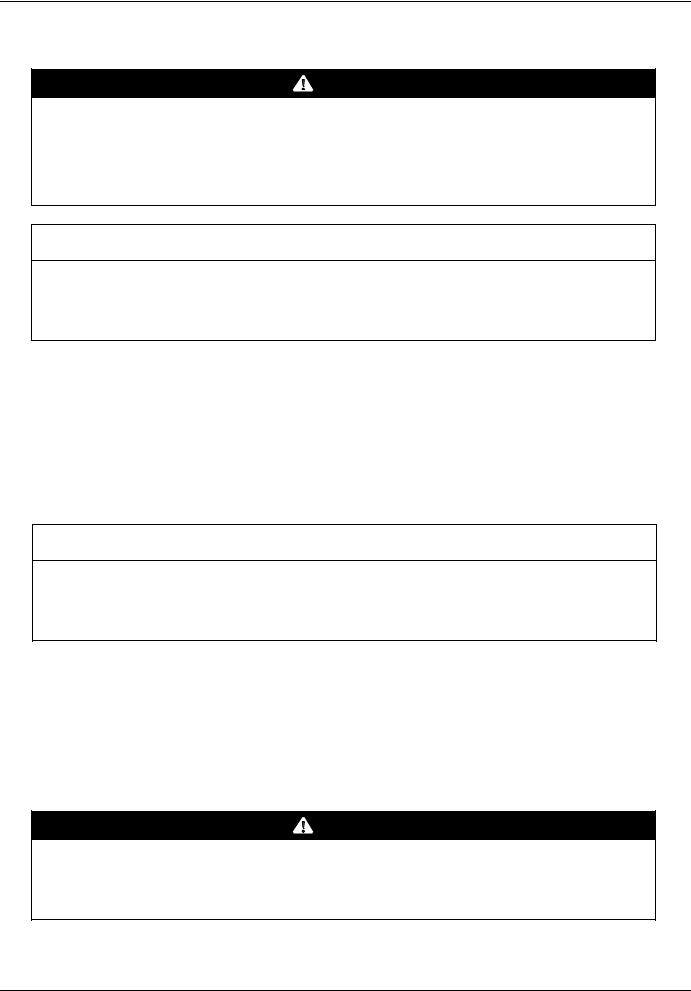
Setup - Preliminary recommendations
Turning on and configuring the drive
DANGER
UNINTENDED EQUIPMENT OPERATION
•Before turning on and configuring the Altivar 71, check that the PWR (POWER REMOVAL) input is deactivated (at state 0) in order to prevent unintended operation.
•Before turning on the drive, or when exiting the configuration menus, check that the inputs assigned to the run command are deactivated (at state 0) since they can cause the motor to start immediately.
Failure to follow these instructions will result in death or serious injury.
 CAUTION
CAUTION
INCOMPATIBLE LINE VOLTAGE
Before turning on and configuring the drive, ensure that the line voltage is compatible with the supply voltage range shown on the drive nameplate. The drive may be damaged if the line voltage is not compatible.
Failure to follow this instruction can result in equipment damage.
Separate control section power supply
Only supply power to the power section the next time the drive is powered up when:
A)The drive control section is powered independently of the power section (P24 and 0V terminals).
B)Whenever an option card is added or replaced.
Power switching via line contactor
 CAUTION
CAUTION
RISK OF EQUIPMENT DAMAGE
•Avoid operating the contactor frequently (premature ageing of the filter capacitors).
•Cycle times < 60 s may result in damage to the pre-charge resistor.
Failure to follow these instructions can result in equipment damage.
User adjustment and extension of functions
•The display unit and buttons can be used to modify the settings and to extend the functions described in the following pages.
•Return to factory settings is made easy by the [1.12 FACTORY SETTINGS] (FCS-) menu, see page 248.
•There are three types of parameter:
-Display: Values displayed by the drive
-Adjustment: Can be changed during operation or when stopped
-Configuration: Can only be modified when stopped and no braking is taking place. Can be displayed during operation.
DANGER
UNINTENDED EQUIPMENT OPERATION
•Check that changes made to the settings during operation do not present any danger.
•We recommend stopping the drive before making any changes.
Failure to follow these instructions will result in death or serious injury.
1755855 |
12/2009 |
15 |
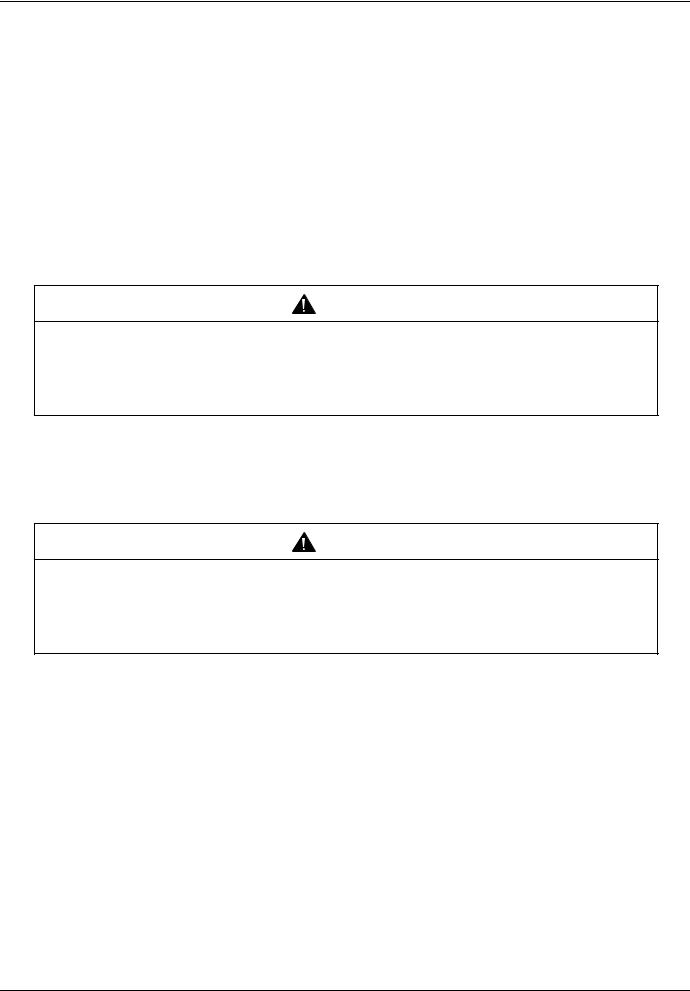
Setup - Preliminary recommendations
Starting
Important:
•In factory settings mode, the motor can only be supplied with power once the “forward”, “reverse” and “DC injection stop” commands have been reset:
- On power-up or a manual fault reset or after a stop command
If they have not been reset, the drive will display "nSt" but will not start.
•If the automatic restart function has been configured ([Automatic restart] (Atr) parameter in the [1.8-FAULT MANAGEMENT] (FLt-) menu, see page 221), these commands are taken into account without a reset being necessary.
Test on a low power motor or without a motor
•In factory settings mode, [Output Phase Loss] detection (OPL) page 224 is active (OPL = YES). To check the drive in a test or maintenance environment without having to switch to a motor with the same rating as the drive (particularly useful in the case of high power drives), deactivate [Output Phase Loss] (OPL = no).
•Configure [Motor control type] (Ctt) = [V/F 2pts] (UF2) or [V/F 5pts] (UF5) ([1.4-MOTOR CONTROL] (drC-) menu, see page 71)
CAUTION
UNINTENDED EQUIPMENT OPERATION
Motor thermal protection will not be provided by the drive if the motor current is less than 0.2 times the rated drive current. Provide an alternative means of thermal protection.
Failure to follow this instruction can result in equipment damage.
Using motors in parallel
• Configure [Motor control type] (Ctt) = [V/F 2pts] (UF2) or [V/F 5pts] (UF5) ([1.4-MOTOR CONTROL] (drC-) menu, see page 71)
CAUTION
UNINTENDED EQUIPMENT OPERATION
Motor thermal protection is no longer provided by the drive. Provide an alternative means of thermal protection on every motor.
Failure to follow this instruction can result in equipment damage.
16 |
1755855 |
12/2009 |
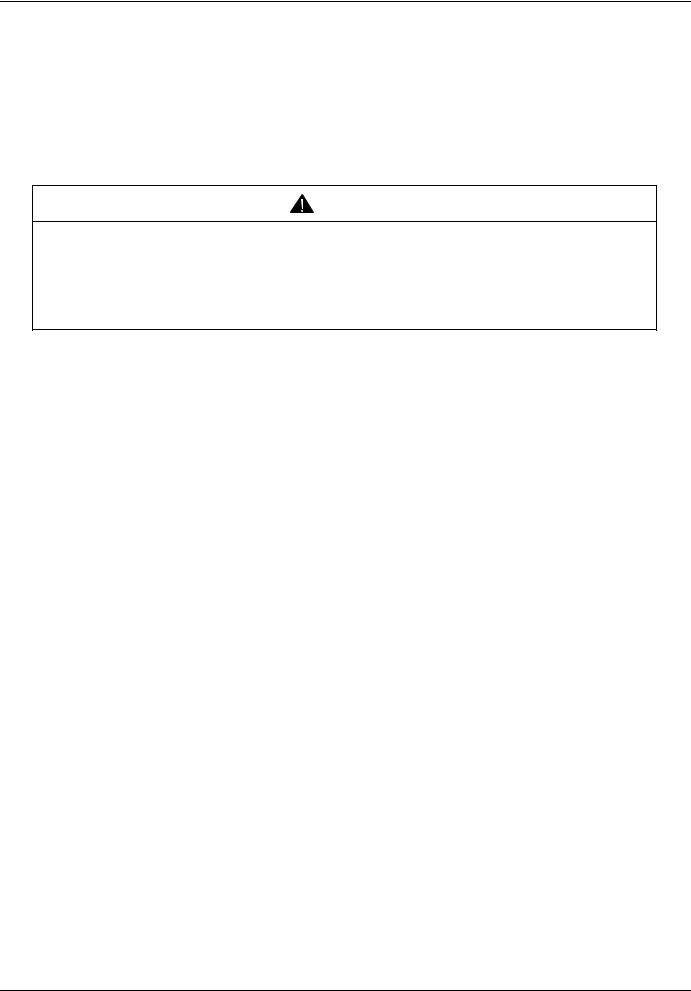
Setup - Preliminary recommendations
ATV71pppY - Network which presents often under voltage
To assure an optimal running of an ATV71pppY used on network which presents often under voltage (network voltage contained between 425 V and 446 V), it is necessary to adjust [Prevention level] (UPL) = 383 V ([1.8-FAULT MANAGEMENT] (FLt-) menu, see page 229).
Using motor with nominal voltage lower than drive supply voltage
• Configure [Vector Control 2pt] (UC2) = [Yes] (YES) ([1.4-MOTOR CONTROL] (drC-) menu, see page 73)
CAUTION
UNINTENDED EQUIPMENT OPERATION
•To protect a motor which has a nominal voltage lower than drive supply voltage, it is mandatory to use [Vector Control 2pt] (UC2) function in order to limit maximal voltage of the motor lower than network voltage.
•Nevertheless, it is necessary to check that instantaneous voltage applied to the motor (link to DC bus voltage) are compatible with characteristics of this one.
Failure to follow these instructions can result in equipment damage.
1755855 |
12/2009 |
17 |

Graphic display terminal
Although the graphic display terminal is optional for low-power drives, it is a standard component on high-power drives (see catalog). The graphic display terminal can be disconnected and connected remotely (on the door of an enclosure for example) using the cables and accessories available as options (see catalog).
Description of terminal
1 Graphic display
2 Function keys F1, F2, F3, F4, see page 19.
3 STOP/RESET button
4 RUN button
7 ESC key: Aborts a value, a parameter or a menu to return to the previous selection
 6 Button for reversing the direction of rotation of the motor
6 Button for reversing the direction of rotation of the motor
5 Navigation button: |
|
|
• |
Press (ENT): |
- To save the current value |
|
|
- To enter the selected menu or parameter |
• |
Turn CW/ |
- To increment or decrement a value |
|
CCW: |
- To go to the next or previous line |
|
|
- To increase or decrease the reference if control via |
|
|
the terminal is activated |
Note: Buttons 3, 4, 5 and 6 can be used to control the drive directly, if control via the terminal is activated.
Disconnected terminal
When the terminal is disconnected, 2 LEDs become visible:
Green LED: |
|
|
|
Red LED: |
DC bus ON |
|
|
|
|
|
|
|
Fault |
|
|
|
|
||
|
|
|
|
HMI Modbus
18 1755855 12/2009

Graphic display terminal
Description of the graphic screen
1 |
|
|
RDY |
Term |
+0.00 Hz |
0A |
|
||||
|
|
||||||||||
|
|
|
|
|
|
|
|
|
6 |
||
2 |
|
|
|
1 DRIVE MENU |
|
|
|
|
|
||
|
|
|
|
|
|
|
|
||||
|
|
|
|
|
|
|
|||||
|
|
|
|
|
|
||||||
1.1SIMPLY START
1.2MONITORING
31.3 SETTINGS
1.4MOTOR CONTROL
1.5INPUTS / OUTPUTS CFG
4 |
Code |
<< |
>> |
Quick |
5 |
|
F1 |
F2 |
F3 |
F4 |
|
1.Display line. Its content can be configured; the factory settings show:
•The drive state (see page 20)
•The active control channel:
-Term: Terminals
-HMI: Graphic display terminal
-MDB: Integrated Modbus
-CAN: Integrated CANopen
-NET: Communication card
-APP: Controller Inside card
•Frequency reference
•Current in the motor
2.Menu line. Indicates the name of the current menu or submenu.
3.Menus, submenus, parameters, values, bar charts, etc., are displayed in drop-down window format on a maximum of 5 lines. The line or value selected by the navigation button is displayed in reverse video.
4.Section displaying the functions assigned to the F1 to F4 keys and aligned with them, for example:
• |
Code |
F1 |
: Displays the code of the selected parameter, i.e., the code corresponding to the 7-segment display. |
|
• |
HELP |
F1 |
: |
Contextual help |
• |
<< |
F2 |
: Navigate horizontally to the left, or go to previous menu/submenu or, for a value, go to the next digit up, displayed |
|
|
|
|
|
in reverse video (see the example on page 21). |
• |
>> |
F3 |
: Navigate horizontally to the right or go to next menu/submenu (going to the [2 ACCESS LEVEL] menu in this |
|
|
|
|
|
example) or, for a value, go to the next digit down, displayed in reverse video (see the example on page 21). |
• |
Quick |
F4 |
: |
Quick navigation, see page 25. |
The function keys are dynamic and contextual.
Other functions (application functions) can be assigned to these keys via the [1.6 COMMAND] menu.
If a preset speed is assigned to a function key and if the function key is pressed, the motor will run at this preset speed until another preset speed or JOG is pressed, speed reference is changed, or Stop key is pressed.
5. 
 Indicates that there are no more levels below this display window. Indicates that there are more levels below this display window.
Indicates that there are no more levels below this display window. Indicates that there are more levels below this display window.
6. |
|
|
Indicates that this display window does not scroll further up. |
|
|
|
|
||
|
|
|
Indicates that there are more levels above this display window. |
|
|
|
|
|
|
|
|
|
|
|
1755855 |
12/2009 |
19 |
||

Graphic display terminal
Drive state codes:
-ACC: Acceleration
-CLI: Current limit
-CTL: Controlled stop on input phase loss
-DCB: DC injection braking in progress
-DEC: Deceleration
-FLU: Motor fluxing in progress
-FST: Fast stop
-NLP: No line power (no line supply on L1, L2, L3)
-NST: Freewheel stop
-OBR: Auto-adapted deceleration
-PRA: Power Removal function active (drive locked)
-RDY: Drive ready
-RUN: Drive running
-SOC: Controlled output cut in progress
-TUN: Auto-tuning in progress
-USA: Undervoltage alarm
20 |
1755855 |
12/2009 |

Graphic display terminal
Example configuration windows:
RDY |
Term |
+0.00Hz |
0A |
When only one selection is possible, the selection made is indicated by |
|
5 LANGUAGE |
|
Example: Only one language can be chosen. |
|
English |
|
|
|
|
Français |
|
|
|
|
Deutsch |
|
|
|
|
Español |
|
|
|
|
Italiano |
|
|
|
|
|
<< |
>> |
Quick |
|
Chinese |
|
|
|
|
Turkish |
|
|
|
|
Russian |
|
|
|
|
PARAMETER SELECTION
1.3 SETTINGS
Ramp increment
Acceleration
Deceleration
Acceleration 2
Deceleration 2
Edit
When multiple selection is possible, the selections made are indicated by  Example: A number of parameters can be chosen to form the [USER MENU].
Example: A number of parameters can be chosen to form the [USER MENU].
Example configuration window for one value:
RDY |
Term |
+0.00Hz |
0A |
|
|
|
RDY |
Term |
+0.00Hz |
0A |
||
Acceleration |
|
|
|
>> |
|
Acceleration |
|
|
||||
|
|
.51 s |
|
|
|
|
|
|
|
|
||
|
|
|
|
|
|
9 |
51 s |
|
||||
|
9 |
|
|
|
|
|
|
|||||
Min = 0.01 |
|
|
Max = 99.99 |
|
|
|
Min = 0.01 |
|
|
Max = 99.99 |
||
|
<< |
>> |
Quick |
|
|
|
|
<< |
|
>> |
Quick |
|
The << and >> arrows (keys F2 and F3) are used to select the digit to be modified, and the navigation button is rotated to increase or decrease this number.
1755855 |
12/2009 |
21 |

Graphic display terminal
First power-up - [5. LANGUAGE] menu
The first time the drive is powered up, the user will automatically be guided through the menus as far as [1. DRIVE MENU].
The parameters in the [1.1 SIMPLY START] submenu must be configured and auto-tuning performed before the motor is started up.
ATV31HU22N4
2.2kW/3HP 380/480V Config. n°1
3 seconds
5 LANGUAGE
English
Français
Deutsch
Español
Italiano
Chinese
Russian
Turkish
Display for 3 seconds following power-up
Automatically switches to [5 LANGUAGE] menu 3 seconds later.
Select the language and press ENT.
RDY |
Term +0.00Hz 0.0A |
|
2 ACCESS LEVEL |
Basic |
|
Standard
Advanced
Expert
Switches to [2 ACCESS LEVEL] menu (see page 31)
Select the access level and press ENT.
RDY |
Term +0.00Hz 0.0A |
|
1 DRIVE MENU |
1.1 SIMPLY START
1.2.MONITORING
1.3.SETTINGS
1.4.MOTOR CONTROL
1.5.INPUTS / OUTPUTS CFG
Code |
<< |
>> |
Quick |
Switches to [1 DRIVE MENU] (see page 27)
ESC
RDY |
Term +0.00Hz |
0.0A |
|
|
MAIN MENU |
|
Press ESC to return to [MAIN MENU] |
1 DRIVE MENU
2 ACCESS LEVEL
3 OPEN / SAVE AS
4PASSWORD
5LANGUAGE
Code |
Quick |
22 |
1755855 |
12/2009 |
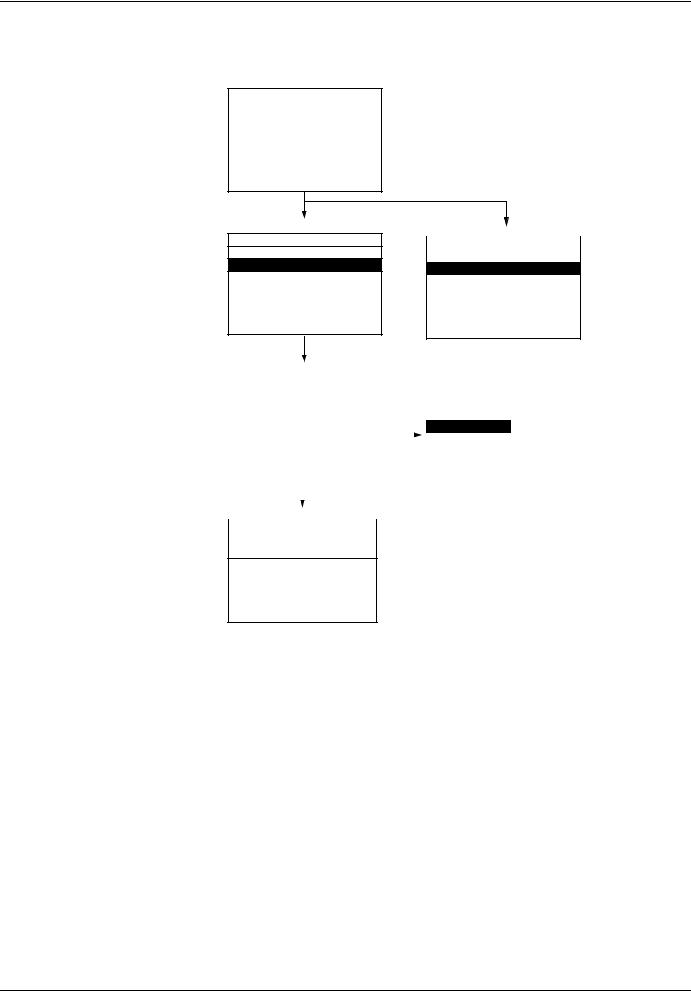
Graphic display terminal
Subsequent power ups
3 seconds later, switches to [1. DRIVE MENU] or to
[1.14 PROGRAMMABLE CARD].
If no operator inputs are made, switches to "Display" automatically 10 seconds later (the display will vary depending on the selected configuration).
Users can return to [MAIN MENU] by pressing ENT or ESC.
ATV71HU22N4
2.2kW/3HP 380/480V Config. n°1
3 seconds
RDY Term +38Hz 0A
1.DRIVE MENU
1.1SIMPLY START
1.2MONITORING
1.3SETTINGS
1.4MOTOR CONTROL
1.5INPUTS / OUTPUTS CFG
Code |
<< |
>> |
Quick |
or, if the Controller Inside card is present
RDY |
Term |
+0.00Hz |
0A |
1.14 PROGRAMMABLE CARD |
|||
Modbus add Prg C. |
|
:17 |
|
DATE/TIME SETTINGS |
|
||
|
|
|
|
|
<< |
>> |
Quick |
10 seconds
RDY |
|
Term |
+38Hz |
|
|
|
0A |
|
|
|
|
|
|
|
|
|
Menu selected in |
|||||||||||||
|
|
|
|
|
|
|
|
RDY |
Term |
+0.00Hz |
0A |
|||||||||||||||||||
|
|
|
|
|
Frequency ref. |
|
|
|
|
|
|
|
|
|
|
|
|
[Power up menu] |
||||||||||||
|
|
|
|
|
|
|
|
|
|
|
|
|
|
|
1.3 SETTINGS |
|
||||||||||||||
|
|
|
|
|
|
|
|
|
|
|
|
|
|
|
|
|
|
|
|
|
|
|
|
|
|
|
||||
|
|
|
|
|
|
|
|
|
|
|
|
|
|
|
|
|
|
|
|
|
|
|
|
|
|
|
|
|
page 265 |
|
|
|
|
|
|
38 Hz |
|
|
|
|
|
|
|
ENT |
Ramp increment: |
|
|
01 |
|||||||||||||
|
|
|
|
|
|
|
|
|
|
|
|
Acceleration |
|
|
9.51 s |
|
||||||||||||||
|
|
|
|
|
|
|
|
|
|
|
|
|
|
|
|
|
|
|
|
|
|
|
|
|
|
|
|
|||
|
|
|
|
|
|
|
|
|
|
|
|
|
|
|
|
|
|
|
|
|
|
|
|
|
Deceleration: |
|
|
9.67 s |
|
|
|
|
|
|
|
|
|
|
|
|
|
|
|
|
|
|
|
|
|
|
|
|
|
|
|
|
|
|
|||
|
|
|
|
|
|
|
|
|
|
|
|
|
|
|
|
|
|
|
|
|
|
|
|
|
Acceleration 2: |
|
|
12.58 s |
|
|
|
Min=0 |
|
|
|
|
|
|
|
|
|
Max=60 |
|
|
|
|
|
|
|
||||||||||||
|
|
|
|
|
|
|
|
|
|
|
|
|
|
Deceleration 2: |
|
|
13.45 s |
|
||||||||||||
|
|
|
|
|
|
|
|
|
|
|
|
|
|
|
|
|
Quick |
|
|
|
|
|
|
|
||||||
|
|
|
|
|
|
|
|
|
|
|
|
|
|
|
|
|
|
|
|
|
Code |
<< |
>> |
Quick |
|
|||||
ESC |
|
|
|
|
|
|
|
|
|
|
|
|
|
|
|
|
|
|
|
|
|
|
||||||||
|
|
|
|
|
|
|
|
|
|
|
|
|
|
|
|
|
|
|
|
|
|
|
|
|
|
|
||||
|
|
|
|
|
|
|
|
|
|
|
|
|
|
|
|
|
|
|
|
|
|
|
|
|
|
|
||||
|
|
|
|
|
|
|
|
|
|
|
|
|
|
|
|
|
|
|
|
|
|
|
|
|
|
|
|
|
|
|
RDY |
|
Term |
+38Hz |
|
0A |
|
|
|
|
|
|
|
|
|
|
|||||||||||||||
|
|
|
|
|
|
|
MAIN MENU |
|
|
|
|
|
|
|
|
|
|
|
|
|
|
|
||||||||
1 DRIVE MENU |
|
|
|
|
|
|
|
|
|
|
|
|
|
|
|
|
|
|
|
|
|
|||||||||
|
|
|
|
|
|
|
|
|
|
|
|
|
|
|
|
|
|
|
|
|
|
|
|
|
|
|
|
|
|
|
2 ACCESS LEVEL
3 OPEN / SAVE AS
4PASSWORD
5LANGUAGE
Code |
Quick |
1755855 |
12/2009 |
23 |

Graphic display terminal
Programming: Example of accessing a parameter
Accessing the acceleration ramp
RDY |
Term |
+0.00Hz |
0A |
|
|
|
|
|
RDY |
Term |
+0.00Hz |
0A |
|
|
|
|
|
RDY |
Term |
+0.00Hz |
0A |
||
|
|
1 DRIVE MENU |
|
|
|
|
|
|
|
1.3 SETTINGS |
|
|
|
|
|
|
|
Acceleration |
|
||||
1.1 SIMPLY START |
|
|
|
ENT |
Ramp increment: |
|
01 |
|
ENT |
|
|
|
|
|
|||||||||
1.2 |
MONITORING |
|
|
|
|
|
|
|
Acceleration |
|
9.51 s |
|
|
|
|
|
|
|
|
|
|
||
|
|
|
|
|
|
|
|
|
|
|
|
|
|
9. |
5 |
1 s |
|
||||||
1.3 |
SETTINGS |
|
|
|
ESC |
Deceleration: |
|
9.67 s |
ENT or |
|
|
||||||||||||
|
|
|
|
|
|
|
|
|
|||||||||||||||
1.4 |
MOTOR CONTROL |
|
|
Acceleration 2: |
|
12.58 s |
Min = 0.01 |
|
|
Max = 99.99 |
|||||||||||||
1.5 |
INPUTS / OUTPUTS CFG |
|
|
|
|
|
|
Deceleration 2: |
|
13.45 s |
|
|
|
|
|
|
|
||||||
|
|
|
|
|
|
|
|
|
|||||||||||||||
|
|
|
|
|
|
|
ESC |
|
|
||||||||||||||
Code |
<< |
>> |
Quick |
|
|
|
|
|
Code |
<< |
>> |
Quick |
|
<< |
|
>> |
Quick |
||||||
Note:
•To select a parameter:
-Turn the navigation button to scroll vertically.
•To modify a parameter:
-Use the << and >> keys (F2 and F3) to scroll horizontally and select the digit to be modified (the selected digit changes to white on a black background).
-Turn the navigation button to modify the digit.
•To cancel the modification:
-Press ESC.
•To save the modification:
-Press the navigation button (ENT).
24 |
1755855 |
12/2009 |

Graphic display terminal
Quick navigation
If the "Quick" function is displayed above the F4 key, you can gain quick access to a parameter from any screen.
Example:
RDY |
Term |
+0.00Hz 0A |
1.4 MOTOR CONTROL |
||
Standard mot. freq: |
5 0Hz IEC |
|
Rated motor power: 0.37 kW (0.5 HP)
Rated motor volt.: |
|
206 V |
|
Rated mot. current: |
|
1.0 A |
|
Rated motor freq.: |
|
50.0 Hz |
|
Code |
<< |
>> |
Quick |
Press F4 to access the Quick screen, which contains 4 selection options.
• [HOME]: Return to [MAIN MENU].
RDY |
Term +0.00Hz |
0A |
|
QUICK NAVIGATION |
|
RETURN TO MAIN MENU DIRECT ACCESS TO...
10 LAST MODIFICATIONS GOTO MULTIPOINT SCREEN
Code
ENT |
See page 266 |
RDY Term +0.00Hz 0A
MAIN MENU
1 DRIVE MENU
2 ACCESS LEVEL
3 OPEN / SAVE AS
4PASSWORD
5LANGUAGE
Code |
Quick |
•[DIRECT ACCESS TO...] : Opens the direct access window, which will contain the text "1". The function keys << and >> (F2 and F3) can be used to select each of the numbers and the navigation button to increment or decrement the numbers: 1.3 in the example below.
RDY |
Term |
+0.00Hz 0A |
|
|
RDY |
Term |
+0.00Hz |
0A |
|
DIRECT ACCESS TO... |
|
|
|
1.3 SETTINGS |
|
||
|
1.3 |
ENT |
Ramp increment: |
|
01 |
|||
|
|
|
Acceleration |
|
9.51 s |
|||
|
|
|
||||||
|
SETTINGS |
|
|
Deceleration: |
|
9.67 s |
||
|
|
|
Acceleration 2: |
|
12.58 s |
|||
|
|
|
|
|
|
|||
|
|
|
|
|
Deceleration 2: |
|
13.45 s |
|
|
<< |
>> |
|
|
Code |
<< |
>> |
Quick |
•[10 LAST MODIFICATIONS]: Opens a window in which the last 10 parameters modified can be accessed directly.
RDY |
Term |
+0.00Hz 0A |
|
|
|
RDY |
Term |
+0.00Hz 0A |
|
10 LAST MODIFICATIONS |
|
|
|
|
Rated mot. current |
||
Acceleration: |
10 s |
|
|
|
|
|
|
|
ENA prop.gain: |
1.2 |
ENT |
|
15.0 A |
||||
Rated mot. current: |
15 A |
|
|
|
|
|||
|
|
|
|
|||||
Preset speed 4: |
20 Hz |
|
|
|
|
|
|
|
ESC |
|
|
|
|||||
Preset speed 5: |
30 Hz |
|
|
|
||||
Code |
|
|
|
|
|
<< |
>> |
|
1755855 |
12/2009 |
25 |
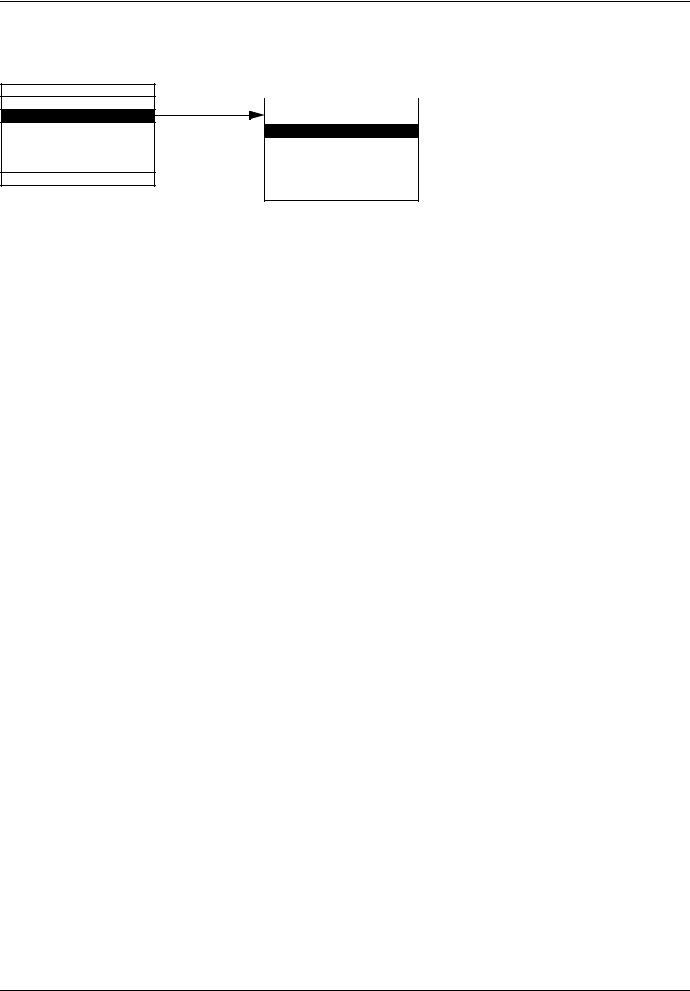
Graphic display terminal
[MAIN MENU] - Menu mapping
RDY |
Term +0.00Hz |
0A |
|
MAIN MENU |
|
1 DRIVE MENU |
|
|
2 ACCESS LEVEL |
|
|
3 OPEN / SAVE AS |
|
|
4 PASSWORD |
|
|
5 LANGUAGE |
|
|
Code |
|
Quick |
6 MONITORING CONFIG. |
|
|
7 DISPLAY CONFIG. |
|
|
RDY |
Term +0.00Hz 0A |
|
1 DRIVE MENU |
1.1SIMPLY START
1.2MONITORING
1.3SETTINGS
1.4MOTOR CONTROL
1.5INPUTS / OUTPUTS CFG
Code |
<< |
>> |
Quick |
1.6COMMAND
1.7APPLICATION FUNCT.
1.8FAULT MANAGEMENT
1.9COMMUNICATION
1.10DIAGNOSTICS
1.11IDENTIFICATION
1.12FACTORY SETTINGS
1.13USER MENU
1.14PROGRAMMABLE CARD
Content of [MAIN MENU] menus
[1 DRIVE MENU] |
See next page |
|
|
|
|
[2 ACCESS LEVEL] |
Defines which menus can be accessed (level of complexity) |
|
|
|
|
[3 OPEN / SAVE AS] |
Can be used to save and recover drive configuration files |
|
|
|
|
[4 PASSWORD] |
Provides password protection for the configuration |
|
|
|
|
[5 LANGUAGE] |
Language selection |
|
|
|
|
[6 MONITORING CONFIG.] |
Customization of information displayed on the graphic display terminal during operation |
|
|
|
|
[7 DISPLAY CONFIG.] |
• |
Customization of parameters |
|
• |
Creation of a customized user menu |
|
• |
Customization of the visibility and protection mechanisms for menus and parameters |
|
|
|
26 |
1755855 |
12/2009 |

Graphic display terminal
[1 DRIVE MENU]
RDY |
Term +0.00Hz 0A |
|
1 DRIVE MENU |
1.1SIMPLY START
1.2MONITORING
1.3SETTINGS
1.4MOTOR CONTROL
1.5INPUTS / OUTPUTS CFG
Code |
<< |
>> |
Quick |
1.6COMMAND
1.7APPLICATION FUNCT.
1.8FAULT MANAGEMENT
1.9COMMUNICATION
1.10DIAGNOSTICS
1.11IDENTIFICATION
1.12FACTORY SETTINGS
1.13USER MENU
1.14PROGRAMMABLE CARD
Content of [1. DRIVE MENU] menus:
[1.1 SIMPLY START]: |
Simplified menu for a quick start |
[1.2 MONITORING]: |
Visualization of current, motor and input/output values |
[1.3 SETTINGS]: |
Accesses the adjustment parameters, which can be modified during operation |
[1.4 MOTOR CONTROL]: |
Motor parameters (motor nameplate, auto-tuning, switching frequency, control algorithms, etc.) |
[1.5 INPUTS / OUTPUTS CFG]: |
I/O configuration (scaling, filtering, 2-wire control, 3-wire control, etc.) |
[1.6 COMMAND]: |
Configuration of command and reference channels (graphic display terminal, terminals, bus, etc.) |
[1.7 APPLICATION FUNCT.] : |
Configuration of application functions (e.g., preset speeds, PID, brake logic control, etc.) |
[1.8 FAULT MANAGEMENT]: |
Configuration of fault management |
[1.9 COMMUNICATION]: |
Communication parameters (fieldbus) |
[1.10 DIAGNOSTICS]: |
Motor/drive diagnostics |
[1.11 IDENTIFICATION]: |
Identifies the drive and the internal options |
[1.12 FACTORY SETTINGS]: |
Access to configuration files and return to factory settings |
[1.13 USER MENU]: |
Specific menu set up by the user in the [7. DISPLAY CONFIG.] menu |
[1.14 PROGRAMMABLE CARD]: : |
Configuration of optional Controller Inside card |
1755855 |
12/2009 |
27 |
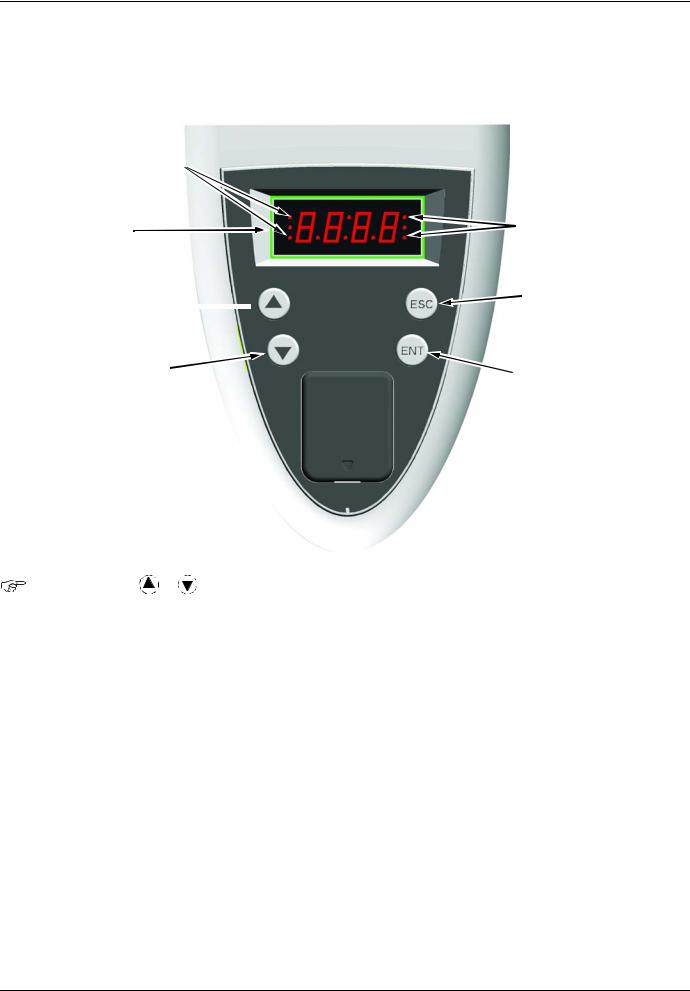
Integrated display terminal
Low-power Altivar 71 drives (see catalog) feature an integrated display terminal with a 7-segment 4-digit display. The graphic display terminal described on the previous pages can also be connected to these drives as an option.
Functions of the display and the keys
• 2 Modbus status LEDs
• Four 7-segment
displays
•Returns to the previous
menu or parameter, or increases the
increases the
displayed value
• Goes to the next menu or parameter, or  decreases the displayed value
decreases the displayed value
•2 CANopen status LEDs
•Exits a menu or parameter, or aborts the displayed value to return to the previous value in the memory
•Enters a menu or parameter, or saves the displayed parameter or value
Note: |
• Pressing |
or |
does not store the selection. |
• Press and hold down (>2 s)  or
or  to scroll through the data quickly.
to scroll through the data quickly.
Save and store the selection: ENT
The display flashes when a value is stored.
Normal display, with no fault present and no startup:
-43.0 : Display of the parameter selected in the SUP menu (default selection: motor frequency)
-CLI: Current limit
-CtL: Controlled stop on input phase loss
-dCb: DC injection braking in progress
-FLU: Motor fluxing in progress
-FSt: Fast stop.
-nLP: No line power (no line supply on L1, L2, L3)
-nSt: Freewheel stop
-Obr: Auto-adapted deceleration
-PrA: Power Removal function active (drive locked)
-rdY = Drive ready
-SOC: Controlled output cut in progress
-tUn: Auto-tuning in progress
-USA: Undervoltage alarm
The display flashes to indicate the presence of a fault.
28 |
1755855 |
12/2009 |
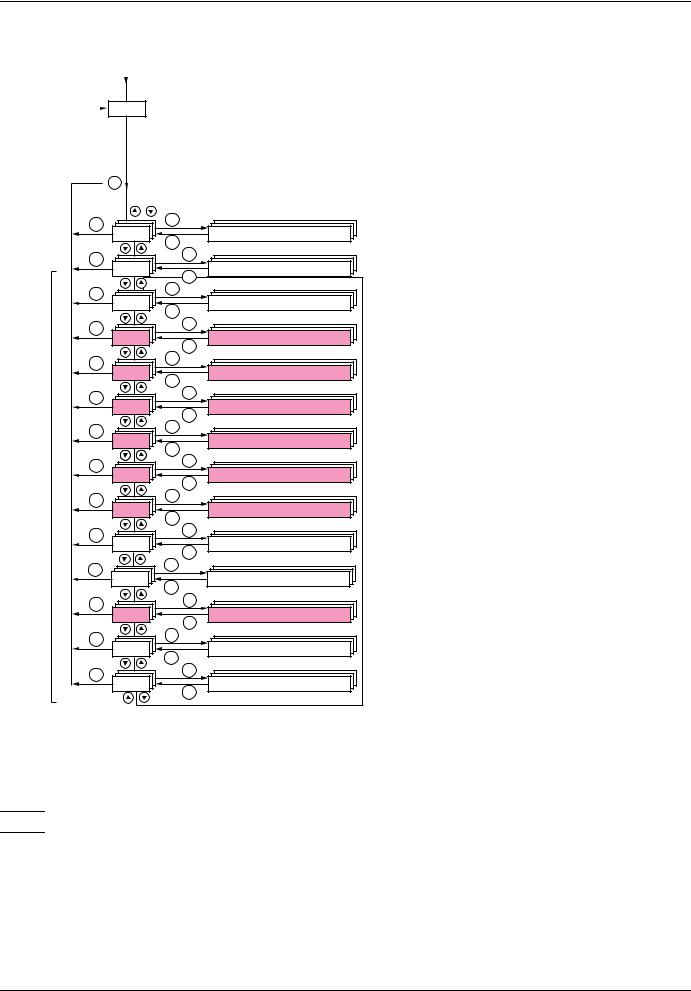
Integrated display terminal
Accessing menus
Power-up
XXX Displays the state of the drive
ENT |
|
|
ESC |
ENT |
|
SIMPLY START |
||
SIM- |
||
|
ESC |
|
ESC |
ENT |
|
MONITORING |
||
SUP- |
||
|
ESC |
|
ESC |
ENT |
|
SETTINGS |
||
SEt- |
||
|
ESC |
|
ESC |
ENT |
|
MOTOR CONTROL |
||
drC- |
||
|
ESC |
|
ESC |
ENT |
|
INPUTS / OUTPUTS CFG |
||
I-O- |
||
|
ESC |
|
ESC |
ENT |
|
COMMAND |
||
CtL- |
||
Menus |
ESC |
|
|
||
ESC |
ENT |
|
APPLICATION FUNCT. |
||
FUn- |
||
|
ESC |
|
ESC |
ENT |
|
FAULT MANAGEMENT |
||
FLt- |
||
|
ESC |
|
ESC |
ENT |
|
COMMUNICATION |
||
CON- |
||
|
ESC |
|
ESC |
ENT |
|
FACTORY SETTINGS |
||
FCS- |
||
|
ESC |
|
ESC |
ENT |
|
USER MENU |
||
USr- |
||
|
ESC |
|
ESC |
ENT |
|
PROGRAMMABLE CARD |
||
SPL- |
||
|
ESC |
|
ESC |
ENT |
|
PASSWORD |
||
COd- |
||
|
ESC |
|
ESC |
ENT |
|
ACCESS LEVEL |
||
LAC- |
||
|
ESC |
(page 37) Simplified menu for fast startup
(page 45) Visualization of current, motor and input/output values
(page 54) Adjustment parameters, can be modified during operation
(page 70) Motor parameters (motor nameplate, auto-tuning, switching frequency, control algorithms, etc.)
(page 88) I/O configuration (scaling, filtering, 2-wire control 3-wire control, etc.)
(page 116) Configuration of command and reference channels (graphic display terminal, terminals, bus, etc.)
(page 129)Configuration of application functions (e.g., preset speeds, PID, brake logic control, etc.)
(page 217) Configuration of fault management
(page 241) Communication parameters (fieldbus)
(page 248) Access to configuration files and return to factory settings
(page 251) Specific menu, set up by the user using the graphic display terminal.
(page 252) Menu for the Controller Inside card, if present.
(page 255)
(page 31)
A dash appears after menu and submenu codes to differentiate them from parameter codes.
Examples: FUnmenu, ACC parameter.

 The grayed-out menus may not be accessible depending on the control access (LAC) configuration.
The grayed-out menus may not be accessible depending on the control access (LAC) configuration.
1755855 |
12/2009 |
29 |
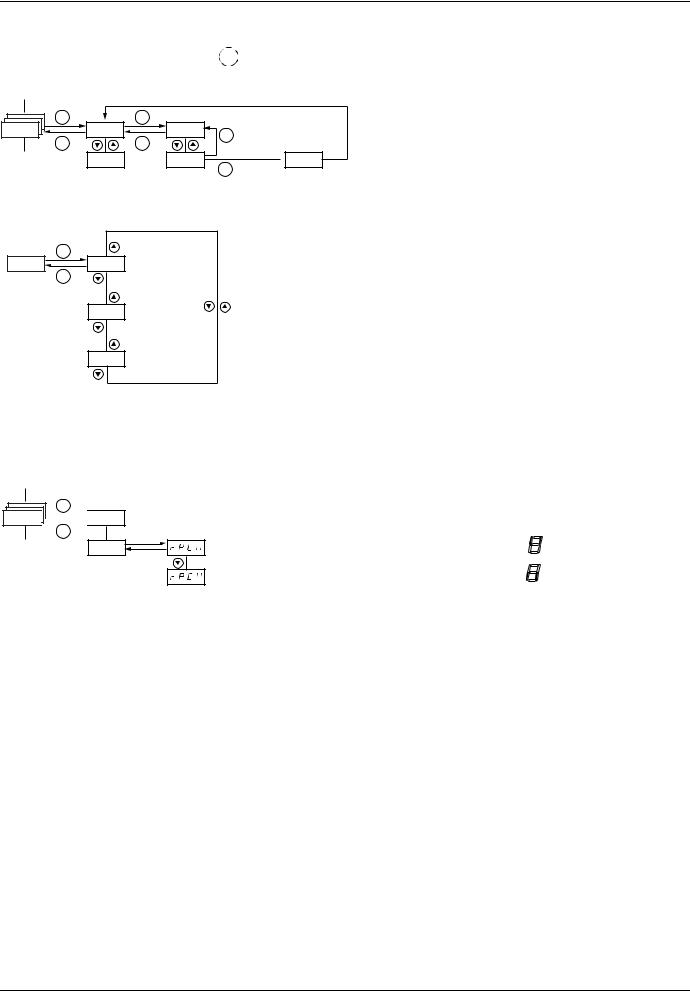
Integrated display terminal
Accessing menu parameters
Save and store the displayed selection : ENT
Menu |
Parameter |
Value or assignment |
The display flashes when a value is stored. |
|
|
|
|
|
|
|
|
|
(Next parameter)
|
|
1st |
Menu |
|
|
1 flash
(save)

All the menus are "drop-down" type menus, which means that after the last parameter, if you continue to press  , you will return to the first parameter and, conversely, you can switch from the first parameter to the last parameter by pressing
, you will return to the first parameter and, conversely, you can switch from the first parameter to the last parameter by pressing  .
.
nth
last
Selection of multiple assignments for one parameter
ENT
I-O-



ESC
Example: List of group 1 alarms in [INPUTS / OUTPUTS CFG] menu (I-O-)
A number of alarms can be selected by "checking" them as follows.
Alarm not selected |
The digit on the right indicates: |
selected |
|
Alarm selected |
not selected. |
|
|
|
The same principle is used for all multiple selections. |
30 |
1755855 |
12/2009 |
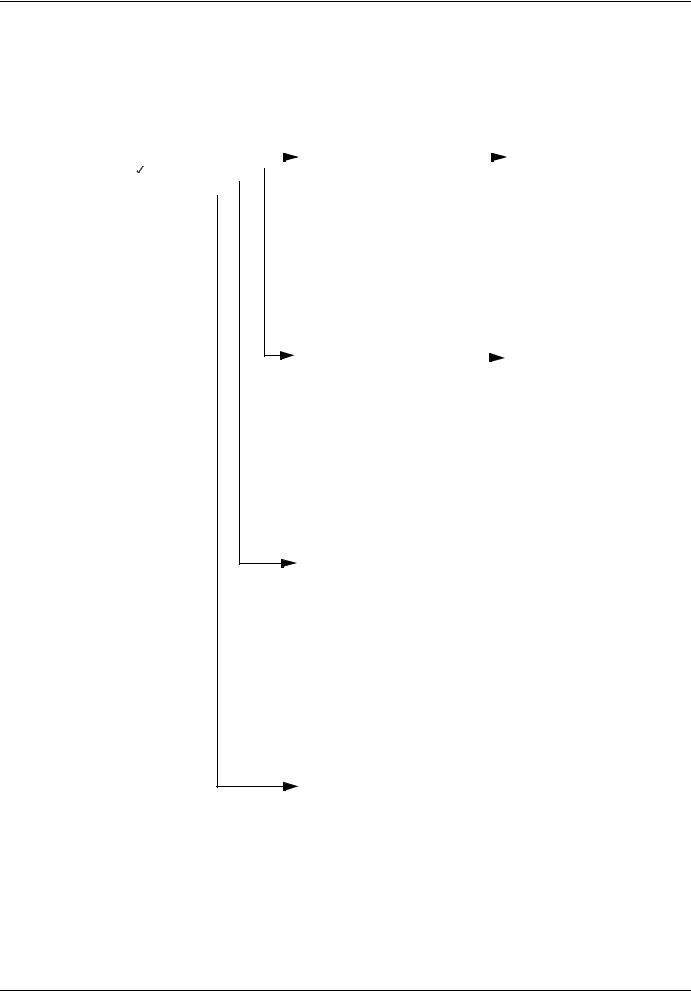
[2. ACCESS LEVEL] (LAC-)
With graphic display terminal
Basic
Access to 5 menus only, and access to 6 submenus only in the [1. DRIVE MENU] menu.
A single function can be assigned to each input.
RDY |
Term |
+0.00Hz |
0A |
|
|
|
|
|
|
RDY |
Term |
+0.00Hz |
0A |
|
|
|
RDY |
Term |
+0.00Hz |
0A |
|
2 ACCESS LEVEL |
|
|
|
|
|
|
|
|
MAIN MENU |
|
|
|
|
|
1. DRIVE MENU |
|
|||
Basic |
|
|
|
|
|
|
|
|
|
1 DRIVE MENU |
|
|
|
|
|
1.1 SIMPLY START |
|
|
||
|
|
|
|
|
|
|
|
|
|
|
|
|
||||||||
Standard |
|
|
|
|
|
|
|
|
|
2 ACCESS LEVEL |
|
|
|
|
|
1.2. MONITORING |
|
|
||
|
|
|
|
|
|
|
|
|
|
|
||||||||||
Advanced |
|
|
|
|
|
|
|
|
|
3 OPEN / SAVE AS |
|
|
|
|
|
1.3. SETTINGS |
|
|
||
|
|
|
|
|
|
|
|
|
|
|
||||||||||
Expert |
|
|
|
|
|
|
|
|
|
4 PASSWORD |
|
|
|
|
|
1.11. IDENTIFICATION |
|
|||
|
|
|
|
|
|
|
|
|
|
|||||||||||
|
|
|
|
|
|
|
|
|
|
5 LANGUAGE |
|
|
|
|
|
1.12. FACTORY SETTINGS |
|
|||
|
<< |
>> |
Quick |
|
|
|
|
|
|
Code |
<< |
>> |
Quick |
|
|
|
Code |
<< |
>> |
Quick |
|
|
|
|
|
|
|
|
|
|
|
|
|
|
|
|
|
1.13 USER MENU |
|
|
|
Standard
This is the factory-set level. Access to 6 menus only, and access to all submenus in the [1. DRIVE MENU] menu.
A single function can be assigned to each input.
RDY |
Term |
+0.00Hz |
0A |
|
|
|
|
RDY |
Term |
+0.00Hz |
0A |
|
MAIN MENU |
|
|
|
|
|
|
1 DRIVE MENU |
|
||
1 DRIVE MENU |
|
|
|
|
|
|
1.1 SIMPLY START |
|
|
||
|
|
|
|
|
|
|
|||||
2 ACCESS LEVEL |
|
|
|
|
|
|
1.2 MONITORING |
|
|
||
3 OPEN / SAVE AS |
|
|
|
|
|
|
1.3 SETTINGS |
|
|
||
4 PASSWORD |
|
|
|
|
|
|
1.4 MOTOR CONTROL |
|
|||
5 LANGUAGE |
|
|
|
|
|
|
1.5 INPUTS / OUTPUTS CFG |
|
|||
Code |
|
|
Quick |
|
|
|
|
Code |
<< |
>> |
Quick |
6 MONITORING CONFIG. |
|
|
|
|
|
1.6 COMMAND |
|
|
|||
|
|
|
|
|
|
|
|
1.7 APPLICATION FUNCT. |
|
||
Advanced |
|
|
|
|
|
|
1.8 FAULT MANAGEMENT |
|
|||
|
|
|
|
|
|
1.9 COMMUNICATION |
|
||||
Access to all menus and submenus. |
|
1.10 DIAGNOSTICS |
|
||||||||
Several |
functions can |
be assigned |
to 1.11 IDENTIFICATION |
|
|||||||
each input. |
|
|
|
|
|
|
1.12 FACTORY SETTINGS |
|
|||
|
|
|
|
|
|
|
|
1.13 USER MENU |
|
|
|
|
|
|
|
|
|
|
|
1.14 PROGRAMMABLE CARD |
|
||
RDY |
Term |
+0.00Hz |
0A |
|
|
|
|
|
|||
|
|
|
|
|
|
||||||
|
MAIN MENU |
|
|
|
|
|
|
|
|
|
|
1 DRIVE MENU |
|
|
|
|
|
|
|
|
|
|
|
2 ACCESS LEVEL |
|
|
|
|
|
|
|
|
|
|
|
3 OPEN / SAVE AS |
|
|
|
|
|
|
|
|
|
|
|
4 PASSWORD |
|
|
|
|
|
|
|
|
|
|
|
5 LANGUAGE |
|
|
|
|
|
|
|
|
|
|
|
Code |
|
|
Quick |
|
|
|
|
|
|
|
|
6 MONITORING CONFIG. |
|
|
|
|
|
|
|
|
|
||
7 DISPLAY CONFIG. |
|
|
|
|
|
|
|
|
|
||
Expert
Access to all menus and submenus as for [Advanced] level, and access to additional parameters.
Several functions can be assigned to each input.
RDY |
Term +0.00Hz |
0A |
|
MAIN MENU |
|
1 DRIVE MENU |
|
|
2 ACCESS LEVEL |
|
|
3 OPEN / SAVE AS |
|
|
4 PASSWORD |
|
|
5 LANGUAGE |
|
|
Code |
|
Quick |
6 MONITORING CONFIG. |
|
|
7 DISPLAY CONFIG. |
|
|
1755855 |
12/2009 |
31 |
